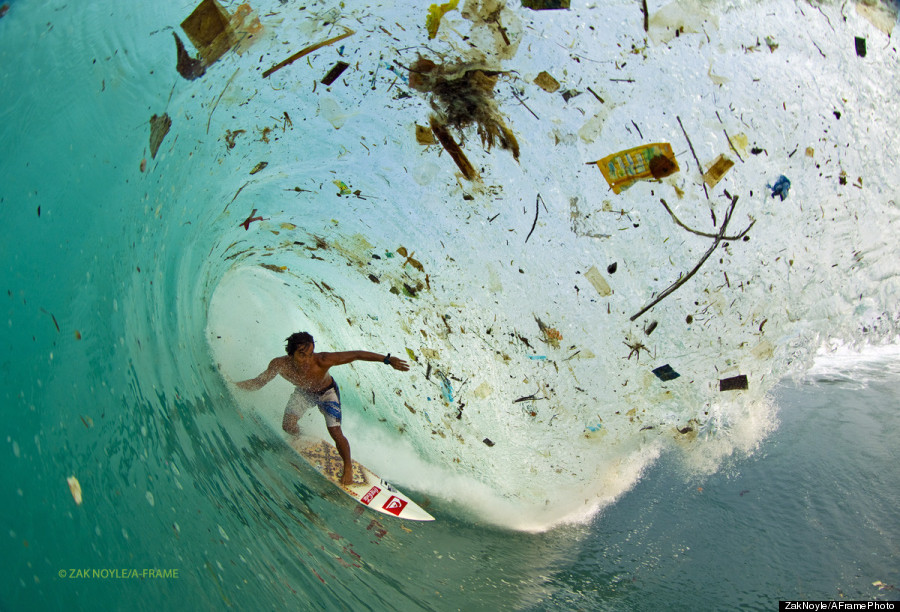Mahmud Hafiz
It was a shocking experience for an investigative environmental journalist to see the exhibits of foreign materials collected from stomach of a dead gray whale at the pacific science center, Seattle, USA. Because he is already aware of plastic pollution in ocean water especially after seeing floating logs in Florence beach of USA west coast and aware about plastic trash hazard for surfing in Java, Indonesia. Being a consistent follower of “Race for Wate


r Odyssey”-an ongoing worldwide ocean expedition for preserving the ocean water, the Journalist is very concerned about growing plastic pollution in oceans due to massive industrialization and development run by World’s Nations.The Journalist here is myself. The exhibits of Seattle Science Center are as simple as of golf ball, nylon rope, juice pack, duct tape, electrical tape, rubber band, surgical glove in a glass-fenced box. Visitors are moving around glimpsing on the box and proceeding for next exhibits. The photo and description inbox attracted me and I stooped proceeding. Members of my family visiting with me did not see extra ordinary something to see for a long. How will they know the? plastic pollution in marine water is always in my mind? Interestingly exhibits shows with a photo of gray whale with the description “The Items you see here accurately represent the foreign material found in the stomach of a gray whale that stranded near West Seattle on April 4, 2010.” The exhibitor of Pacific Science Center mentioned the total weight of plastic and fabrics items are 1443 Grams, and that’s the full stop and I think the things what that I would like to make everybody understand is completely Judged.
In 2016, I got another shock to seeing lots of logs at the Florence beach of USA west coast. I was informed by locals that the national forest located in shoreline of Pacific Ocean sometime becomes great victim of severe erosion due to natural disaster leads the forest broken and logs goes floats in the ocean stream. So needless to say most powerful country of the world also in the list of disposer things to the ocean.
The Us Based International Newspaper Huff Post published a report on 06 December 2017 about severe trash and plastic debris in Java Sea. It said, photographer Zak Noyle discovered on a recent trip to Java, Indonesia. The waves of Java, always known for being pristine and barreling, were now rolling swells of disgusting trash and debris. Noyle was shooting Indonesian surfer Dede Surinaya in a remote bay when he and Surinaya discovered the water to be covered in garbage, according to GrindTV. The bay was miles from any town, yet strong currents had carried the trash of the world’s most populated island, Java, to its once pure waters.
Gabriela Aoun said in the report that Indonesia, a country comprised of more than 17,000 islands, suffers from a terrible trash problem that is polluting its waters. Some of the population centers have little to no trash collection infrastructure, leading locals to dispose of their waste in the street or in river beds, after which it inevitably is washed out to sea.
I wrote an article on ‘Race for water Odyssey-2015’ at the time of its inception. Aim of the adventure was to draw the first global assessment of plastic pollutions in the ocean. The huge oceanic adventure sailed in 15 March 2015 aiming to reach the beaches of islands located in the 5 major ocean gyres – also known as the “trash vortexes”- defined open sea areas with higher concentration of floating debris. Basically oceanic surface currents, floating marine debris – mainly composed of plastic – are accumulating in these vortexes. Marine debris are regularly washed ashore on coastal areas exposed to open seas, and especially islands located within or close to the gyres act like physical barriers. So stranded marine debris represents the plastic pollution in the surrounding waters.
Now we have the Race for Water Odyssey-2015 findings. The 2015 Odyssey made 7 stopovers on various islands or archipelagos (Azores, Bermuda, Easter Island, Hawaii, Mariana, Palau and Mascarene) and sampled the plastic fragments. The team’s observation confirms that the plastic contamination in the oceans is ubiquitous.
The 2015 Odyssey report says, “whether in terms of macro debris (>2.5 cm) or micro plastics (< 5 mm) concentrations, Hawaii constitutes by far the 2015 Odyssey’s most notable hotspot. The highest macro debris concentration registered at Kamilo Point in Hawaii (more than 3,500 macro debris per 100 m2) was almost ten times greater than the second hotspot of the 2015 Odyssey, Pago Bay (372) on Guam Island in the Mariana Archipelago. Hawaii also constitutes the highest micro plastics concentration hotspot with more than 94,000 particles per m2 collected once again at Kamilo Point again. For comparison, the second highest concentration, Ovahe beach on Easter Island, revealed more than 24,000 microparticles per m2.”
‘Race foe Water Odyseey-2017- 2021” began 9 April 2017 for five years following Odyssey 2015 experience aiming to travel around the world to promote solution to preserve the oceans from pollution. It has started its Journey from Lorient and right now experiencing Panama Canal. It has made stopover at Bermuda-America’s Cup-2017 sports event for raising awareness.
The great Odyssey team targeting to attend two major International events: The Tokyo Olympics Games-2020 and Universal Exhibition in Dubai-2021. The booklet of the ongoing Odyssey referring to various studies says, 80% of marine pollutions are plastic. The seven expeditions counted average of 3lac 34 thousands fragments of plastic per square kilometer with peak of 9lac 69 thousand in the study area of 34 Lac square kilometer. It said, plastic production worldwide has increased twenty time higher.
Andreas Merkl, Chief Executive Officer of Ocean Conservancy Organization wrote in his blog referring a recent scientific study by the Journal Science that between five and 12 million metric tons of plastic enter in to the ocean every year. If nothing is done by 2025, there could be one pound of plastic for every three pounds of fish.
Race for water Foundation believe that solution exists. After travelling the world’s seas, the Foundation finds solutions to prevent plastic waste from leaking in to ocean at the same time using it for generating energy. Foundation is going to take a pilot project of plastic to energy.
The Team Odyssey called scientist, academia, researcher and student to come forward to find the way to get rid of it. Oceans cover 72% of the surface of our blue planet and constitute more than 95% of the biosphere consider now a day as hub of blue economy. Considering the average ocean depth of 3,800 meters, it represents 99% of the volume for the human civilization in the biosphere. Life originated in the oceans by generating oxygen, absorbing carbon dioxide, recycling nutrients and regulating global climate and temperature take a major role for saving our civilization. Using the ocean and its resources for sustainable economic developments aiming to establish social equity and justice for overall human well-being are basically blue economy. So we should jump in to immediate action for saving ocean for the sake of human civilization.
(Mahmud Hafiz, writer, traveler, environmental journalist)




